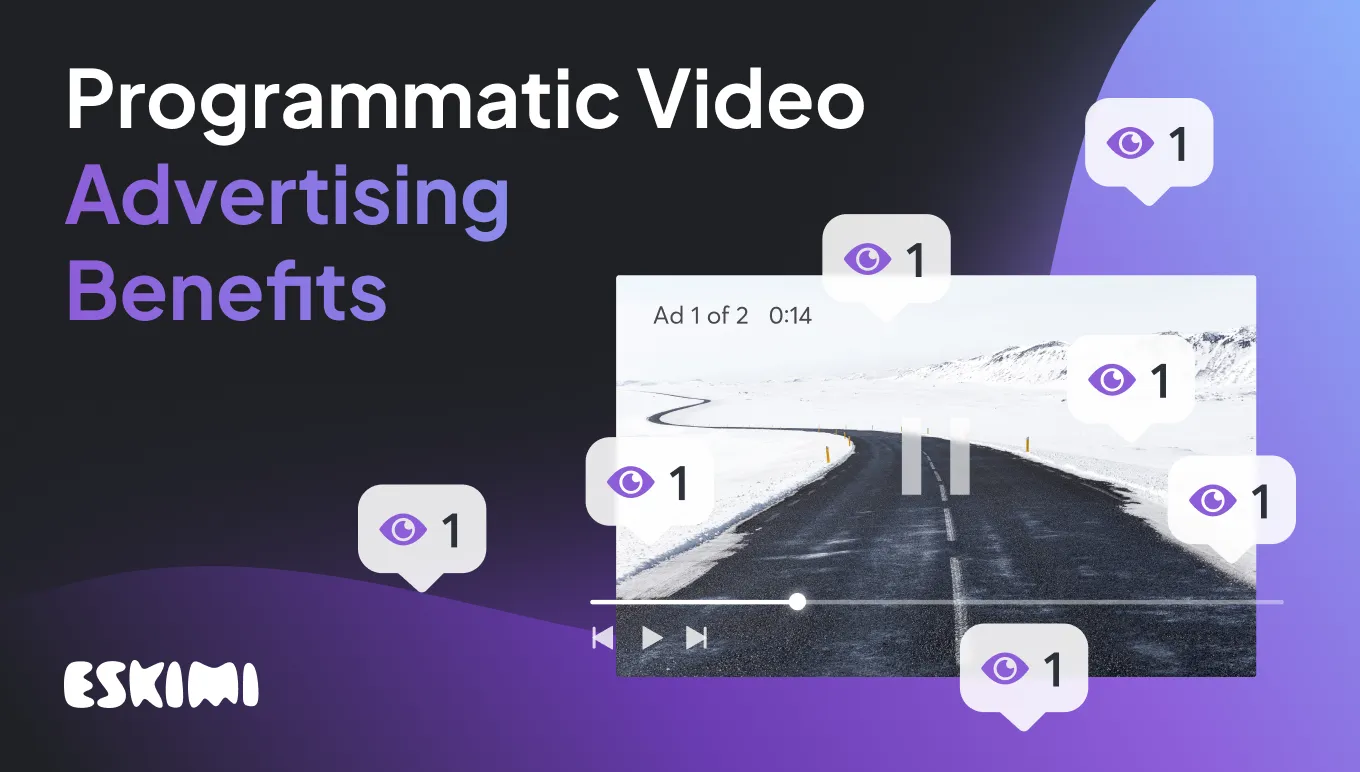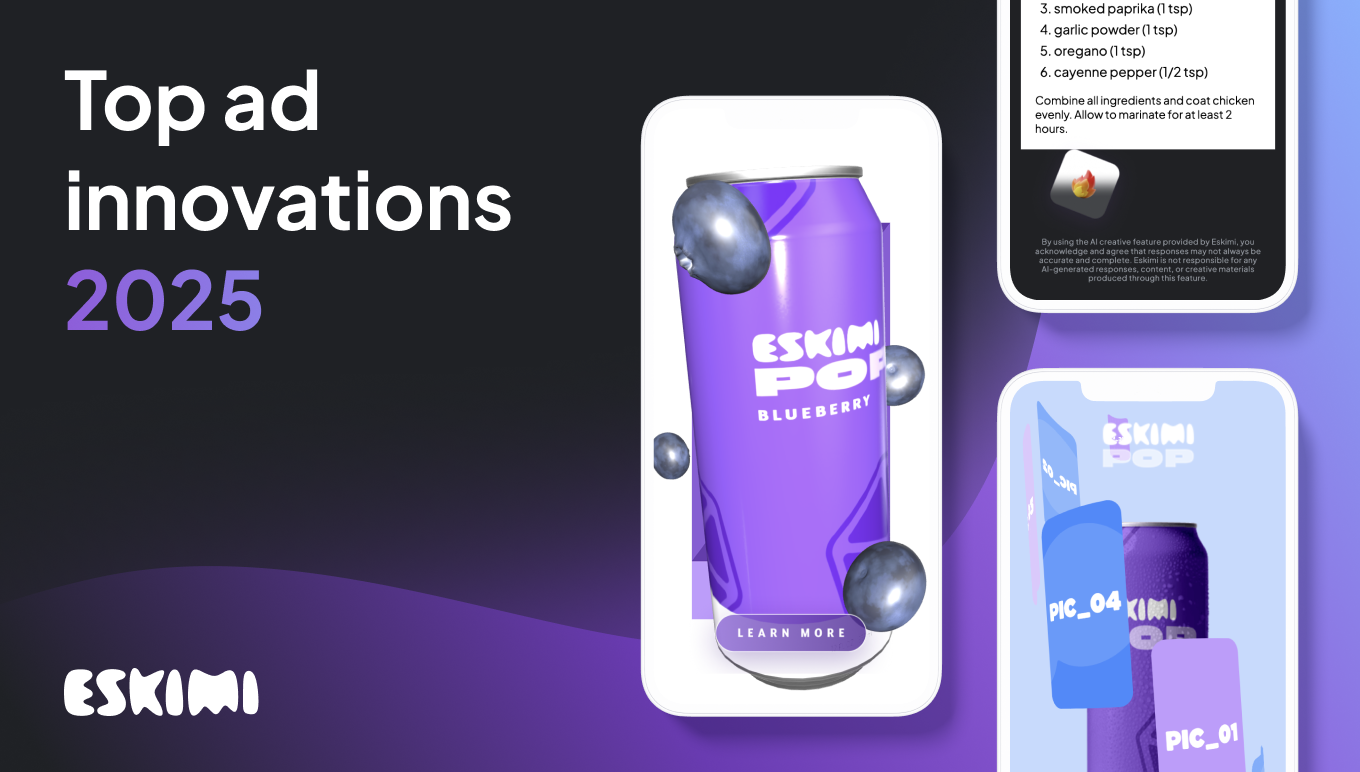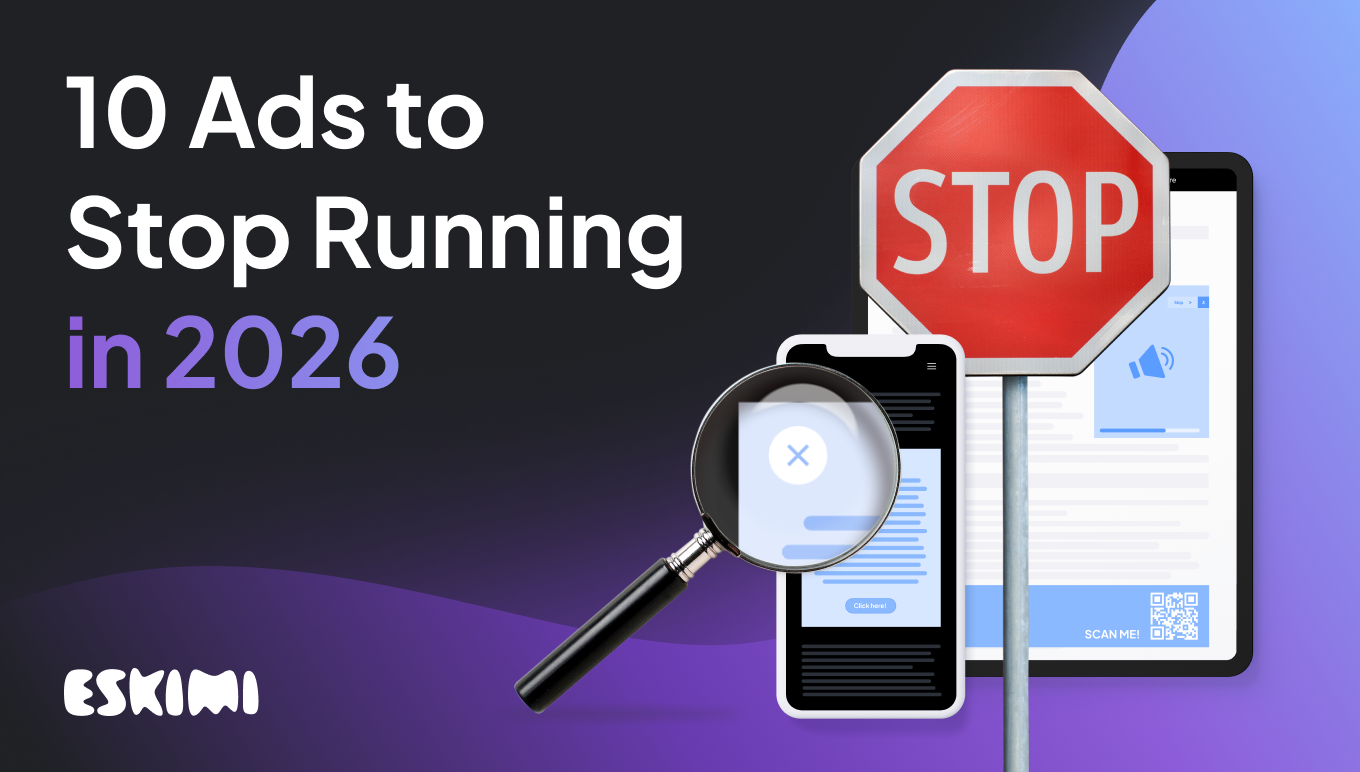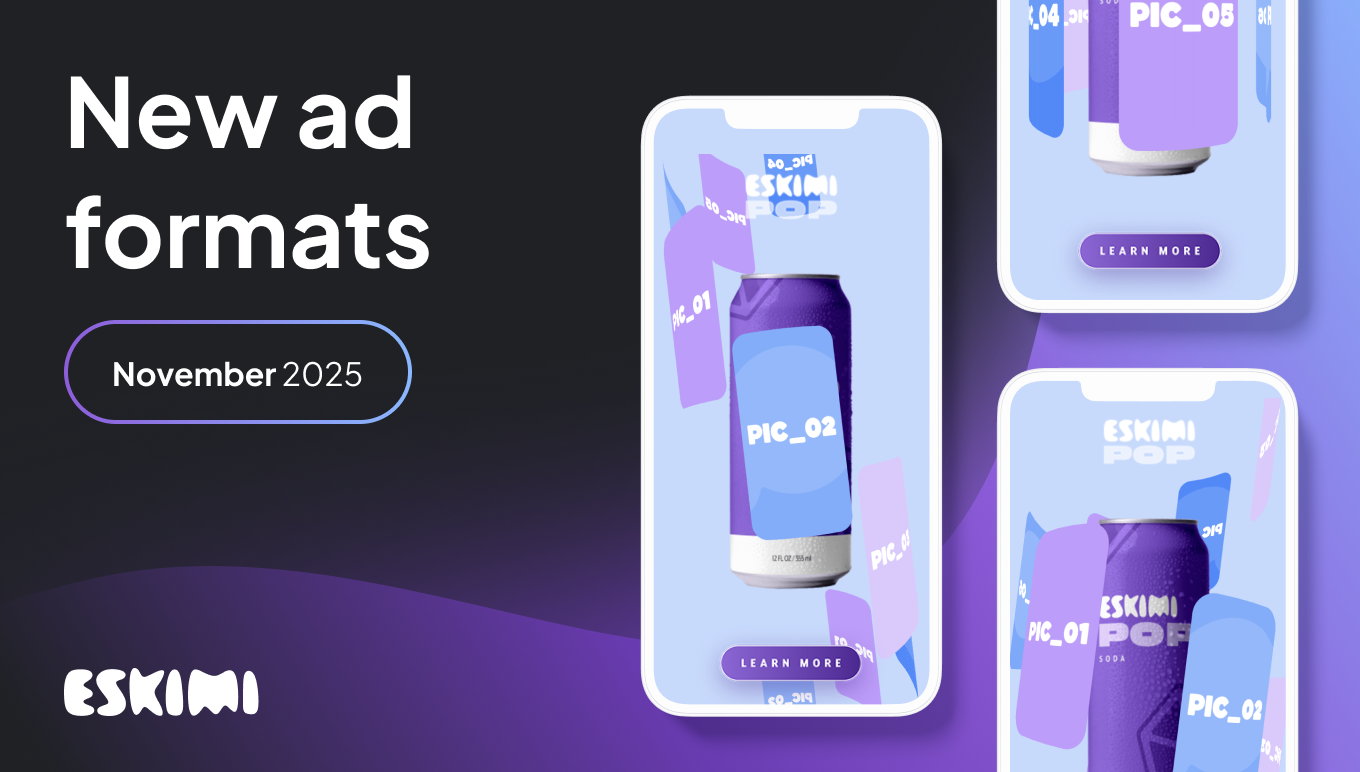6 Benefits Of Programmatic Video Advertising In 2023

There’s never been a better time to start video advertising than now.
The number of internet users consuming video content is increasing every year and is projected to reach nearly 3.5 billion in 2023. That is more than the populations of China, India, and the United States combined.
Video advertising comes in different types and offers a variety of use cases that can help you deliver your message to the right audience. When you add programmatic to it, it only gets better.
Put simply, if you’re excluding video from your digital advertising mix, you might be missing out on some great benefits that come with it.
In this post, you’ll learn what are the key benefits of programmatic video advertising, what types of video ads you can use to achieve your goals, and go through a couple of tips to make it all as effective as possible.
Video advertising in numbers
Video advertising refers to promoting products/services or a brand using short video content. Because of its highly engaging nature, it remains one of the most effective forms of advertising, expected to show an annual growth rate of 10.97% (CAGR 2023-2027).
Here are some other interesting numbers that show how brands rediscover the power of video advertising (Wyzowl, 2023):
- 91% of businesses will use video as a marketing tool in 2023
- 70% of “non-video-marketers” plan to start online video marketing in 2023
- 95% of video marketers say video has helped them increase brand awareness
- 87% of marketers say that video has increased dwell time on their website
- 91% say video has helped them increase traffic
And if this wasn’t enough…
89% of people say that watching a video has convinced them to buy a product or service.
All this also reflects in growing video advertising (desktop + mobile) spending worldwide. Compared to 2022, it is projected to increase by nearly $30B in 2023, getting bigger every year and reaching $318.80B by the end of 2027.

What is programmatic advertising?
Programmatic advertising is the practice of buying (and selling) digital advertising space using dedicated platforms like DSP and SSP.
As opposed to more traditional ways of media buying that often include manual methods, programmatic uses automated technology, large sets of data, and algorithmic tools.
Programmatic video advertising is simply a part of the whole programmatic puzzle that lets advertisers reach their audiences using video format.
The growth of programmatic video advertising
As videos are basically taking over the content world, programmatic video advertising is picking up the pace. More brands are experiencing the benefits of adding it to their advertising mix, and it’s not that difficult to see why.
In the US alone, advertisers have seen a significant boost in programmatic video ad spending, which increased from $52.17B in 2021 to $62.96B in 2022, according to eMarketer.
It is projected that the growth will continue and programmatic video ad spending will increase to $74.88B in 2023.

Key programmatic video advertising benefits
According to the latest data, it’s evident that video is the medium that people want to engage with, leaving brands that are still in doubt no choice but to try it.
If you’re one of them, the benefits of video advertising listed below can help you finally make up your mind.
1. People love watching videos
Just think of how apps like TikTok or features like Instagram and Facebook stories have skyrocketed in popularity in recent years. All of them contain short video content that is easy to consume and highly immersive, therefore, users spend a significant amount of time using these products.
Smartphones, actually, made a significant impact on video growth as users were able to watch videos anytime and anywhere. And they still do.
In other words, video is an easily digestible medium that you can use to kill time, but it can also help to quickly gather the information you need to make an informed (purchase) decision.
This is what gives video advertising its first advantage.
2. You can reach a wider audience
There are several reasons why video ads can help you reach more people.
First, again – people love videos. For instance, YouTube users spend 1 billion hours (!!!) watching them every day.
Videos are easily shareable (actually, more than 50% of people say they’re more likely to share a video with their friends than any other type of content) and can help understand the idea in a shorter time. As a result, consumers are more likely to spend time watching a video ad than, for example, reading a text on your banner. Especially when it’s catchy and relevant.
When combined with already high reach in programmatic, videos can help you significantly increase your chances of delivering a message to your ideal consumer.

3. Higher engagement
Although video is not the only form of visual advertising, it is still among those that can bring higher results.
Compared to images, which are usually easier to scan and better for clicks, videos are better for driving views and engagement – often, comments and shares – since they are longer and evolve around some story.
Put simply – the ability to include various other elements, like motion, sound, and text, makes video ads more dynamic, and in this context, better dynamics mean higher engagement. Using an ad maker can streamline the creation of these dynamic video ads, allowing advertisers to quickly add these elements and boost engagement.
4. Better ad recall
You’ve probably heard that “a picture paints a thousand words,” so it’s fair to say that videos connect those words into stories. And stories are a powerful way of communicating ideas.
Stories help us better understand the information, create continuity, and connect with it emotionally, making your brand narrative more memorable.
Even if you don’t sell on your first time (which is not that uncommon, as we’re sure you know), well-made video ads can help you leave a long-lasting impact and stay at the top of your target audience’s mind, being their first choice once they’re ready to make purchase decisions.
5. Better Return on Investment (ROI)
The key idea of advertising is to put products and services in front of a potential customer, so when we talk about the benefits of video advertising, ROI is an important one.
Whether you’re looking to increase engagement, brand awareness, generate leads, boost retention, or have any other goal, videos are proven to be an effective medium to do it.
Programmatic advertising comes with flexible spending, allowing advertisers to control how much they pay for their campaigns, reducing the chances of spending more than planned/they are able to afford. So running video campaigns programmatically gives you a double advantage, combining the benefits of a highly engaging medium and affordable programmatic ads.
In fact, the latest study by Wyzowl found that 90% of marketers say that video has helped them generate leads.
And on a general level, 92% of video marketers admit that video gives them a good ROI.

6. Great for reaching mobile users
Consuming video content on mobile phones has reached an all-time high – now more than six hours weekly, according to the latest Parks Associates research.
When everyone is immersed in their smartphones so much, and digital advertising keeps evolving, designing your ads for different devices, especially mobile phones, is not an option – it’s a must. Especially when people are 1.5x more likely to watch a video on a smartphone than on a computer.
What’s also crucial is for advertisers to ensure a cohesive mobile video advertising experience for their target audience.
Video ads on mobile don’t really differ visually, but unlike traditional video advertising, mobile video ad size has to be tailored to fit a mobile device’s smaller screen.
Types of video ads
Besides social media (Instagram, Facebook, TikTok, etc.) or YouTube video ads we see daily, there are some other, maybe lesser-known types of programmatic video ads that are worth every advertiser’s attention.
CTV ads

CTV, or connected TV, is a channel that allows advertisers to reach people who are streaming their favorite video content. More brands are discovering it, and there’s just no other choice but to craft a compelling video ad for it (and even an interactive one if you’re up for it!).
The clear benefit of it is that brands can expand their reach beyond regular TV and deliver messages to cord-cutters. Usually, ads can be shown during different content, like premium TV shows or live streams.
Another good news is that CTV is seen as the key growth area for digital video advertising, identified by 67% of responders in the latest IAB report – so definitely something to keep an eye on.
Native video ads
Native advertising lets advertisers run promotions in a less intrusive way, since placements are designed to align with the content's look and feel. For example, if you’re reading an article on some news site, a video ad can be “incorporated” into the article just like images or videos that actually belong there.
If you haven’t tried it yet, it might be a good time to do so, as native video advertising comprised 84.1% of all video ad spend (the US), referring to some pretty heavy usage of this particular video ad type.

Rewarded video
With rewarded videos, it’s pretty straightforward. As the name implies, viewers have the option to watch a video in exchange for some incentive. For instance, an extra life in the game, extended free trial, and similar.
Often, rewarded video ads appear as interstitials (with sound) and cover the whole screen. So if you play a mobile game or read some article, rewarded videos appear on top of the content.
They are usually skippable, and users can simply opt out of watching rewarded videos.
VAST

VAST, or Video Ad Serving Template, is a video ad that is served in a video player on a publisher’s page. Typically, there are two ad formats that are served in the VAST environment:
- In-stream. In this type of video ad serving, ads appear within a player or an app. In this case, a video player is the main “channel” used to serve content to the target audience.
- Out-stream. This type of ad is served alongside the site’s display content. There are many ways how those ads can be implemented, including banner videos or interstitials.
VAST can be either skippable or not, depending on its length. If the video is equal to or less than 5 seconds, it is served as non-skippable, while longer videos include this option not to finish watching the ad.
IBV
IBV, or in-banner-video, is basically an HTML5 video banner that takes up regular banner placements, following standard IAB banner sizes (e.g., 300x250).
IBV comes with such features as companion banners (optional – usually an image that provides more information about promoted products/services), call-to-action (optional), controlling video start, and description (optional – doesn’t appear anywhere visually).
Initiated by users, some IBV ads can expand outside the standard dimensions of the banner.
Floating video ad

Floatings ads are ads that, you guessed it, “floats” on top of content while the user browses the website. Just like it can be a static image, floating ads can also include some motion.
The key difference between these two is that floating video ad tracking additionally includes video metrics. Typically, it is served auto-played and without sound.
What makes a good video ad?
- The first 5 seconds are crucial, so make sure the most attention-grabbing part of your video is at the beginning (also, users can skip most video ads after 5 seconds, and you don’t want that).
- Include a competitive advantage that’ll convince viewers to choose your brand over your competitor’s.
- Find the right length balance – make it long enough to deliver your main message but not too long to leave viewers bored.
- Mix different elements like sound and text to add extra dynamics to your video ad.
- Include a CTA so that viewers would know exactly what to do next.
Conclusion
Videos are one of the most lovable forms of entertainment that most people enjoy daily. It is also an effective way to stay on the top of their minds, so these days, adding video ads to your overall advertising mix simply makes sense.
Considering some other added benefits, such as better ROI, higher engagement, better ad recall, and steadily growing market size, it might be time to put your creative skills to work and start sharing your brand story.
Need help figuring out where to begin? Contact the Eskimi team for guidance or book a demo for a smooth start.
Level Up Your Advertising with Eskimi
- Reach 96% of Open Web
- 2,500+ Targeting Options
- 100% Managed or Self-Service
- In-House Creative Studio Team
- Display, Video, In-Game & CTV
- #1 Rated DSP on G2





